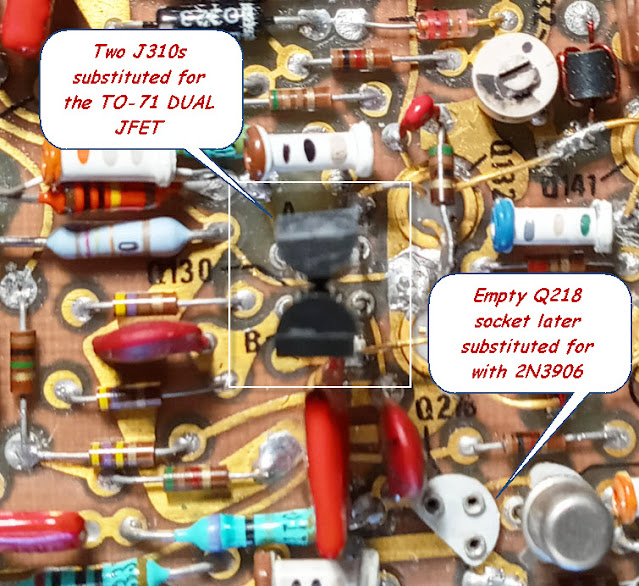So far, despite a visit and some serious time with my good friend, Dick, WB6JDH, we were unable to unravel the mystery of the fading 7D14. We covered a lot of ground but have not yet unlocked the puzzle.
Dick discovered some ambiguity between my unit and the manual documentation and found that the Q218 (151-0271-00, the PNP transistor) was actually in BACKWARDS. Reversing it caused more correct signals to be observed for a longer time. We also discovered ambiguity in the manual documentation between the pin-outs Q130A/Q130B (151-1031-00, the DUAL FET in the TO-71 case) and the diagram in the book. (Will be detailed in subsequent "Chinese Checkers" post.) This led us on a course of substitution -- Q218 was replaced with a 2N3906 and the dual FET was replaced with two J310 FETs. These seemed to work great for an hour of two and then behaved as described and then behaved as I discussed below.
I piddled around a little after Dick left and managed to be present when the TRIGGER SOURCE signal crapped out. I quickly switched the signal to the CHANNEL "A" input BNC and saw that the counter continued to work properly when the INPUT SENSE switch was switched from TRIGGER SOURCE to one of the attenuator positions (as we discussed). I then rigged a "T" connection of the generator signal to the 7A26 CHANNEL 1 input BNC and the CHANNEL "A" BNC such that when the signal died from the TRIGGER SOURCE position, I could quickly switch over to the CHANNEL "A" input.

As time permitted yesterday (tiptoeing around normal duties), I experimented with this setup of switching quickly back and forth between the TRIGGER SOURCE and the CHANNEL "A" inputs. I noted that the counter did not fail in a similar manner as it had in the past. Whereas the display would "fade to zero" in a matter of seconds, now it just grew inaccurate, displaying "20.0xxx" where the "xxx" digits would remain unsteady. When it was switched to the CHANNEL "A" input, the display would revert to a rock solid "20.000" MHz.
I turned my attention to the relays and found that the K106, K101, and K100 units were very hot to the touch but K103 was not.
This morning, I set up a test of the unit again and, while it lasted a full three hours plus, it again failed. This time BOTH the TRIGGER SOURCE and the CHANNEL "A" input displayed zeroes.
The 7D14 manual describes this circuit nicely but I am still puzzled if sticking/malfunctioning relays could cause the problem I am having with this plug in.



No comments:
Post a Comment